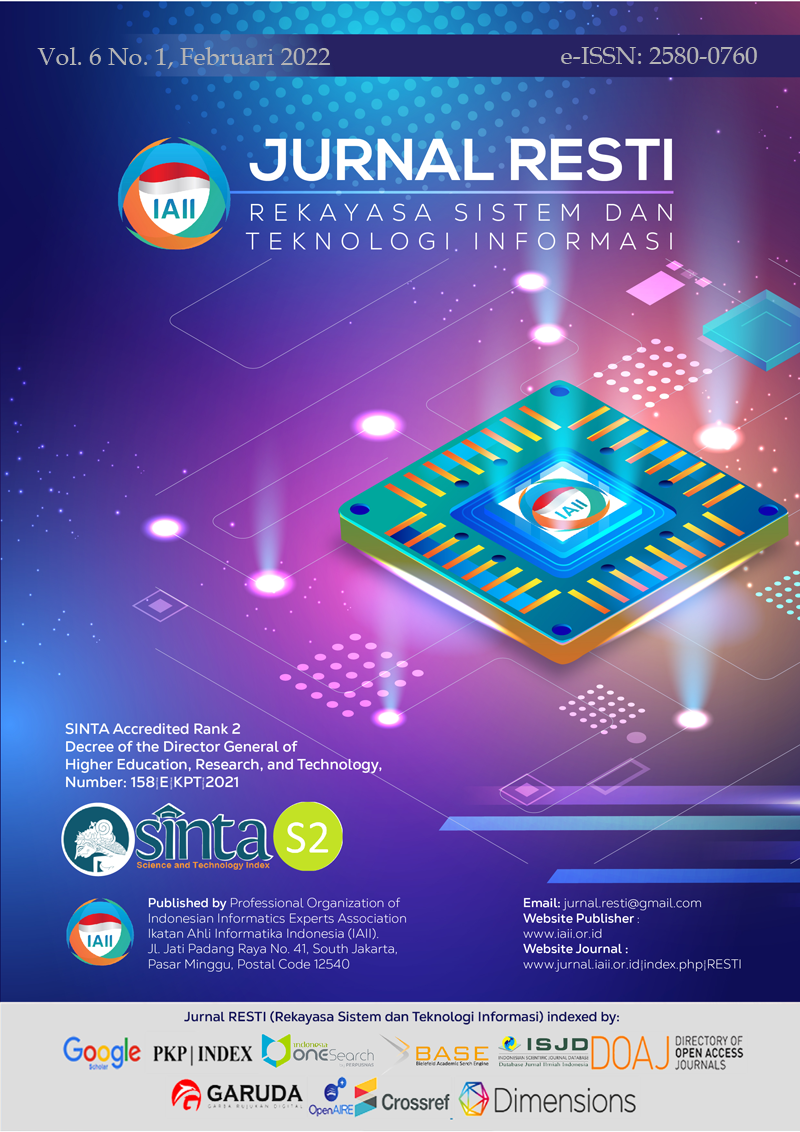Detection of Essential Thrombocythemia based on Platelet Count using Channel Area Thresholding
Abstract
Essential Thrombocythemia is one of the Myeloproliferative Neoplasms Syndrome where the mutation of the JAK2V617F gene causes the bone marrow to produce excessive platelets. For early detection of Essential Thrombocythemia disease using a full blood count and peripheral blood smear examination. The main characteristic is that giant platelets are found as large as young lymphocytes with a number of more than 21 cells in one field of view. The purpose of this research is to detect Essential Thrombocythemia by counting the number of platelets in the peripheral blood smear image. This research utilizes computer vision technique where the research stages consist of peripheral blood smear image, color conversion, image enhancement, segmentation, labeling process, feature extraction and K-Nearest Neighbor classification. There are three features used, namely the number of platelet cells, area and perimeter. The K-Nearest Neighbor method is able to classify 215 training data with an accuracy of 98.13% and classify 40 testing data with an accuracy of 100% based on the value of K = 3.
Downloads
References
A. Tefferi and T. Barbui, “Polycythemia vera and essential thrombocythemia: 2019 update on diagnosis, risk-stratification and management,” Am J Hematol, vol. 94, no. 1, pp. 133–143, Jan. 2019, doi: 10.1002/ajh.25303.
P. A. Beer, W. N. Erber, P. J. Campbell, and A. R. Green, “How I treat essential thrombocythemia,” vol. 117, no. 5, p. 11, 2011.
S. B. McKenzie, J. L. Williams, K. Landis-Piwowar, and Teton Data Systems, Clinical laboratory hematology. Boston: Pearson, 2015. Accessed: Oct. 22, 2021. [Online]. Available: http://VH7QX3XE2P.search.serialssolutions.com/?V=1.0&L=VH7QX3XE2P&S=JCs&C=TC0001352396&T=marc&tab=BOOKS
Z. E. Fitri, I. K. E. Purnama, E. Pramunanto, and M. H. Pumomo, “A comparison of platelets classification from digitalization microscopic peripheral blood smear,” in 2017 International Seminar on Intelligent Technology and Its Applications (ISITIA), Surabaya, Aug. 2017, pp. 356–361. doi: 10.1109/ISITIA.2017.8124109.
S. C. A. Young and K. B. Poulsen, Anderson’s Atlas of Hematology, Third Edition. Burlington: Jones & Bartlett Learning LLC, 2020.
Z. E. Fitri and A. M. N. Imron, “Classification of White Blood Cell Abnormalities for Early Detection of Myeloproliferative Neoplasms Syndrome Using Backpropagation,” in Proceedings of the 1st International Conference on Electronics, Biomedical Engineering, and Health Informatics, vol. 746, Triwiyanto, H. A. Nugroho, A. Rizal, and W. Caesarendra, Eds. Singapore: Springer Singapore, 2021, pp. 499–508. doi: 10.1007/978-981-33-6926-9_43.
Z. E. Fitri, “Klasifikasi Trombosit Pada Citra Hapusan Darah Tepi Berdasarkan Gray Level Co- Occurrence Matrix Menggunakan Backpropagation,” Institut Teknologi Sepuluh Nopember, Surabaya, 2017.
A. M. Nanda Imron and Z. E. Fitri, “A Classification of Platelets in Peripheral Blood Smear Image as an Early Detection of Myeloproliferative Syndrome Using Gray Level Co-Occurence Matrix,” J. Phys.: Conf. Ser., vol. 1201, p. 012049, May 2019, doi: 10.1088/1742-6596/1201/1/012049.
Z. E. Fitri, L. N. Y. Syahputri, and M. N. Imron, “Classification of White Blood Cell Abnormalities for Early Detection of Myeloproliferative Neoplasms Syndrome Based on K-Nearest Neighbor,” Scientific Journal of Informatics, vol. 7, no. 1, p. 7, 2020.
E. M. Keohane, C. N. Otto, and J. M. Walenga, Rodak’s hematology: clinical principles and applications, Sixth edition. St. Louis, Missouri: Elsevier, 2020.
Z. E. Fitri, L. N. Sahenda, P. S. D. Puspitasari, P. Destarianto, D. L. Rukmi, and A. M. N. Imron, “The Classification of Acute Respiratory Infection (ARI) Bacteria Based on K-Nearest Neighbor,” Lontar Komputer : Jurnal Ilmiah Teknologi Informasi, vol. 12, no. 2, p. 11, 2021.
Copyright (c) 2022 Jurnal RESTI (Rekayasa Sistem dan Teknologi Informasi)

This work is licensed under a Creative Commons Attribution 4.0 International License.
Copyright in each article belongs to the author
- The author acknowledges that the RESTI Journal (System Engineering and Information Technology) is the first publisher to publish with a license Creative Commons Attribution 4.0 International License.
- Authors can enter writing separately, arrange the non-exclusive distribution of manuscripts that have been published in this journal into other versions (eg sent to the author's institutional repository, publication in a book, etc.), by acknowledging that the manuscript has been published for the first time in the RESTI (Rekayasa Sistem dan Teknologi Informasi) journal ;








